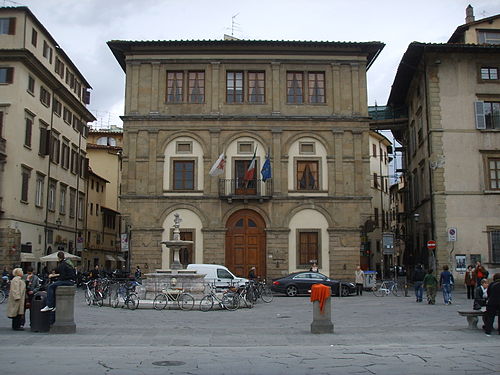
Palazzo Cocchi-Serristori is a Renaissance-style palace in Piazza Santa Croce, Florence, Italy. It presently houses offices of a regional council of Florence.

Palazzo Cocchi-Serristori is a Renaissance-style palace in Piazza Santa Croce, Florence, Italy. It presently houses offices of a regional council of Florence.
It is situated opposite to the church of Santa Croce, in the place where the city's 12th-century walls passed. Facing the church, on the right side of the piazza is the frescoed facade of the Palazzo dell'Antella.
The Cocchi-Serristori palace is a reconstruction of a pre-existing medieval edifice (owned by the Peruzzi), attributed to Giuliano da Sangallo, Baccio d'Agnolo or Simone del Pollaiolo. It has a cubic shape, built with polished stone, with three arcades in the façade enclosed in the original 14th-century piers. At the two upper floors are pilasters with finely sculpted capitals.
In the interior are a frescoed private chapel and, in the staircase, 18th-century frescoes attributed to Atanasio Bimbacci, Dionisio Predellini, and Giuseppe Collignon.
Coordinates: 43°46′9.38″N11°15′38.37″E / 43.7692722°N 11.2606583°E
| This article about a palace in Italy is a stub. You can help Wikipedia by expanding it. |

Foligno is an ancient town of Italy in the province of Perugia in east central Umbria, on the Topino river where it leaves the Apennines and enters the wide plain of the Clitunno river system. It is located 40 kilometres south-east of Perugia, 10 km (6 mi) north-north-west of Trevi and 6 km (4 mi) south of Spello.

Palazzo Mozzi or Palazzo de' Mozzi is an early Renaissance palace, located at the end of the Piazza de' Mozzi that emerges from Ponte alle Grazie and leads straight to the palace where via San Niccolò becomes via de' Bardi in the Quartiere of Santo Spirito in the Oltrarno section of Florence, region of Tuscany, Italy. The 13th-century palace housed the gallery of the highly successful antiquarian Stefano Bardini, of which the remnants were left to the commune, where they assembled the Museo Bardini or Mozzi Bardini, displaying Florentine art and artifacts up to the early Renaissance. The gardens elaborated against the hillside behind the palace were added mainly by Bardini.

Santa Trinita is a Roman Catholic church located in front of the Piazza of the same name, traversed by Via de' Tornabuoni, in central Florence, region of Tuscany, Italy. It is the mother church of the Vallumbrosan Order of monks, founded in 1092 by a Florentine nobleman. South on Via de' Tornabuoni is the Ponte Santa Trinita over the river Arno; across the street is the Palazzo Spini Feroni.
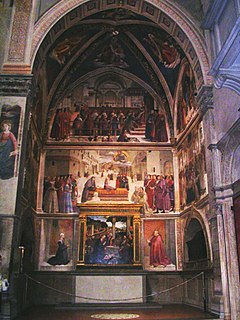
The Sassetti Chapel is a chapel in the basilica of Santa Trinita in Florence, Italy. It is especially notable for its frescoes of the Stories of St. Francis, considered Domenico Ghirlandaio's masterwork.

Palazzo Spini Ferroni is a large Gothic palace located along Via de' Tornabuoni at the corner of Piazza Santa Trinita, in central Florence, region of Tuscany, Italy. It stands across from the church of Santa Trinita.

The historic centre of Florence is part of quartiere 1 of the Italian city of Florence. This quarter was named a World Heritage Site by UNESCO in 1982.

Piazza Santa Croce is one of the main plazas or squares located in the central neighborhood of Florence, region of Tuscany, Italy. It is located near piazza della Signoria and the National Central Library, and takes its name from the Basilica of Santa Croce that overlooks the square.
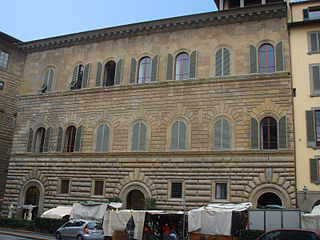
Palazzo Gondi is a palace in Florence, Italy, located a block from Piazza della Signoria. It was built in 1490 under design by Giuliano da Sangallo, who was inspired by other major works of stately buildings in the city, such as Palazzo Medici and Palazzo Strozzi. Among the elements borrowed from these earlier works are the cube-shape set around a central courtyard, the ashlar sloping on each of three floors, and the arched windows.
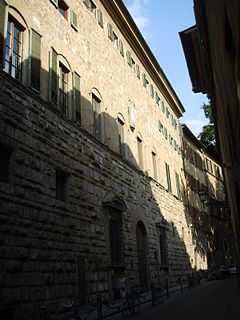
Palazzo Capponi alle Rovinate is a late-Gothic and early Renaissance-style residential palace located on Via de' Bardi in Florence, region of Tuscany, Italy. There are apparently three other palaces once associated with the Capponi family:

Palazzo dell'Antella is a palace with a frescoed façade located on Piazza Santa Croce, Florence, region of Tuscany, Italy.
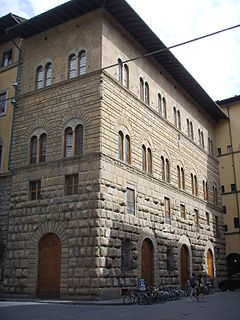
Palazzo dello Strozzino is a Renaissance palace in Florence, region of Tuscany, Italy. The stone Renaissance facade is located on Piazza degli Strozzi, diagonal to the Southeast corner of the imposing Palazzo Strozzi. The Northern façade on Via dei Anselmi houses the entrance to the Cinema Odeon.

The Palazzo Spannocchi is a Renaissance style urban palace located on the Piazza Salimbeni, just off Via Banchi di Sopra in the Terzo di Camollia of the city of Siena, region of Tuscany, Italy. The building was associated with an ancient mercantile family of Siena.

The Palazzo Palmieri, or Palazzo Nuti, is a Mannerist style urban palace, located on Via del Moro #48 in the present contrada of Civetta, Terzo di Camollia of the city of Siena, region of Tuscany, Italy.

The Complesso di San Firenze is a 17th-century Baroque-style building, consisting of a church, palace, and former oratory, located on the southeast corner of the saucer-shaped piazza of San Firenze, located in the quartiere of Santa Croce in central Florence, region of Tuscany, Italy. The buildings were commissioned by the Oratorians of Saint Philip Neri.
The Palazzo Tempi, also known as Palazzo Vettori or Bargagli Petrucci, is a palace located along the Arno river at the narrow Piazza Santa Maria Soprarno 1, corner with Via de' Bardi and Costa dei Magnoli in the Oltrarno section of Florence, Tuscany, Italy. The palace is across the river from the Galleria of the Uffizi, and a block east of the Ponte Vecchio. The Via de' Bardi originates in an arch under the building.
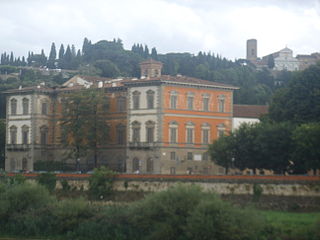
Palazzo Serristori is a Renaissance style palace located between Piazza Demidoff and the Lungarno Serristori in Oltrarno, in the neighborhood of San Niccolò of Florence, region of Tuscany, Italy.

The Palazzo Malvezzi de' Medici is a Renaissance-style palace located on Via Zamboni #13 in central Bologna, Italy. The palace now houses the offices of the Provincial Administration.
Santa Maria Assunta is a Roman Catholic parish church located in Settignano, a frazione of Florence in the region of Tuscany, Italy.

The Episcopal Palace is a building located in Piazza Mino of Fiesole, Italy. Built in the eleventh century, it serves as the residence of the Bishop of Fiesole.